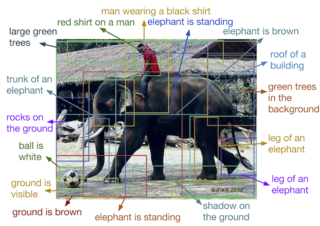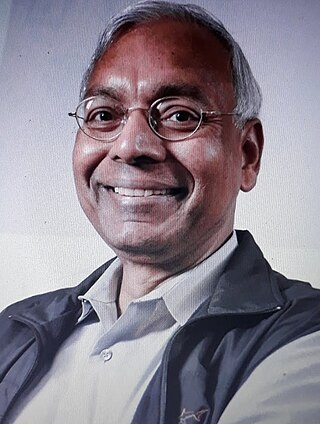Speech processing is the study of speech signals and the processing methods of signals. The signals are usually processed in a digital representation, so speech processing can be regarded as a special case of digital signal processing, applied to speech signals. Aspects of speech processing includes the acquisition, manipulation, storage, transfer and output of speech signals. Different speech processing tasks include speech recognition, speech synthesis, speaker diarization, speech enhancement, speaker recognition, etc.
Pattern recognition is the task of assigning a class to an observation based on patterns extracted from data. While similar, pattern recognition (PR) is not to be confused with pattern machines (PM) which may possess (PR) capabilities but their primary function is to distinguish and create emergent patterns. PR has applications in statistical data analysis, signal processing, image analysis, information retrieval, bioinformatics, data compression, computer graphics and machine learning. Pattern recognition has its origins in statistics and engineering; some modern approaches to pattern recognition include the use of machine learning, due to the increased availability of big data and a new abundance of processing power.

Image registration is the process of transforming different sets of data into one coordinate system. Data may be multiple photographs, data from different sensors, times, depths, or viewpoints. It is used in computer vision, medical imaging, military automatic target recognition, and compiling and analyzing images and data from satellites. Registration is necessary in order to be able to compare or integrate the data obtained from these different measurements.

In mathematics, a time series is a series of data points indexed in time order. Most commonly, a time series is a sequence taken at successive equally spaced points in time. Thus it is a sequence of discrete-time data. Examples of time series are heights of ocean tides, counts of sunspots, and the daily closing value of the Dow Jones Industrial Average.
Robert M. Haralick is Distinguished Professor in Computer Science at Graduate Center of the City University of New York (CUNY). Haralick is one of the leading figures in computer vision, pattern recognition, and image analysis. He is a Fellow of the Institute of Electrical and Electronics Engineers (IEEE) and a Fellow and past president of the International Association for Pattern Recognition. Professor Haralick is the King-Sun Fu Prize winner of 2016, "for contributions in image analysis, including remote sensing, texture analysis, mathematical morphology, consistent labeling, and system performance evaluation".

Automatic image annotation is the process by which a computer system automatically assigns metadata in the form of captioning or keywords to a digital image. This application of computer vision techniques is used in image retrieval systems to organize and locate images of interest from a database.

Thomas M. Cover [ˈkoʊvər] was an American information theorist and professor jointly in the Departments of Electrical Engineering and Statistics at Stanford University. He devoted almost his entire career to developing the relationship between information theory and statistics.
The term kernel is used in statistical analysis to refer to a window function. The term "kernel" has several distinct meanings in different branches of statistics.
Mean shift is a non-parametric feature-space mathematical analysis technique for locating the maxima of a density function, a so-called mode-seeking algorithm. Application domains include cluster analysis in computer vision and image processing.

James Ze Wang is a Chinese-American computer scientist. He is a distinguished professor of the College of Information Sciences and Technology at Pennsylvania State University. He is also an affiliated professor of the Molecular, Cellular, and Integrative Biosciences Program; the Computational Science Graduate Minor; and the Social Data Analytics Graduate Program. He is co-director of the Intelligent Information Systems Laboratory. He was a visiting professor of the Robotics Institute at Carnegie Mellon University from 2007 to 2008. In 2011 and 2012, he served as a program manager in the Office of International Science and Engineering at the National Science Foundation. He is the second son of Chinese mathematician Wang Yuan.

In non-parametric statistics, the Theil–Sen estimator is a method for robustly fitting a line to sample points in the plane by choosing the median of the slopes of all lines through pairs of points. It has also been called Sen's slope estimator, slope selection, the single median method, the Kendall robust line-fit method, and the Kendall–Theil robust line. It is named after Henri Theil and Pranab K. Sen, who published papers on this method in 1950 and 1968 respectively, and after Maurice Kendall because of its relation to the Kendall tau rank correlation coefficient.

Anil Kumar Jain is an Indian-American computer scientist and University Distinguished Professor in the Department of Computer Science & Engineering at Michigan State University, known for his contributions in the fields of pattern recognition, computer vision and biometric recognition. He is among the top few most highly cited researchers in computer science and has received various high honors and recognitions from institutions such as ACM, IEEE, AAAS, IAPR, SPIE, the U.S. National Academy of Engineering, the Indian National Academy of Engineering and the Chinese Academy of Sciences.
Jianchang (JC) Mao is a Chinese-American computer scientist and Vice President, Google Assistant Engineering at Google. His research spans artificial intelligence, machine learning, computational advertising, data mining, and information retrieval. He was named a Fellow of the Institute of Electrical and Electronics Engineers (IEEE) in 2012 for his contributions to pattern recognition, search, content analysis, and computational advertising.
RAMnets is one of the oldest practical neurally inspired classification algorithms. The RAMnets is also known as a type of "n-tuple recognition method" or "weightless neural network".
Keinosuke Fukunaga is a Japanese American scientist and educator known for his contributions to statistical pattern recognition. Fukunaga published some of the earliest monographs in the field of machine learning. He is the author of the book Introduction to Statistical Pattern Recognition, first published in 1972 by Academic Press.
Jiebo Luo is a Chinese-American computer scientist, the Albert Arendt Hopeman Professor of Engineering and professor of computer science at the University of Rochester. He is interested in artificial intelligence, data science and computer vision.
Mark S. Nixon is an author, researcher, editor and an academic. He is the former president of IEEE Biometrics Council, and former vice-Chair of IEEE PSPB. He retired from his position as Professor of Electronics and Computer Science at University of Southampton in 2019.

Jerry M. Mendel is an engineer, academic, and author. He is professor emeritus of Electrical and Computer Engineering at the University of Southern California.








